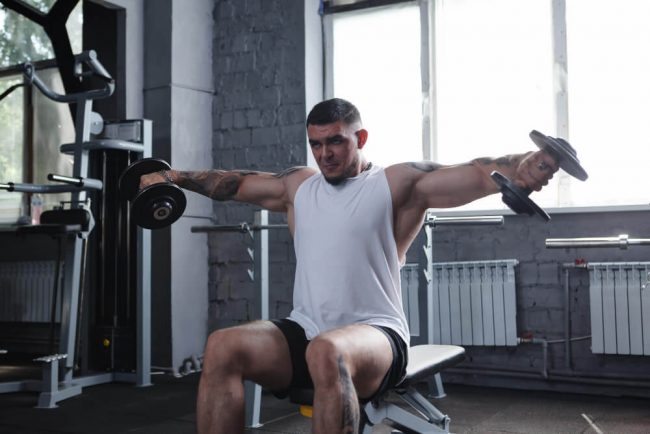Your eating and exercise habits have a direct impact on your capacity to burn fat and gain muscles. Numerous fitness enthusiasts both inside and outs
Your eating and exercise habits have a direct impact on your capacity to burn fat and gain muscles. Numerous fitness enthusiasts both inside and outside of it have simultaneously achieved these objectives, providing anecdotal proof that body recomposition is achievable. It’s normal to lose a little muscle mass when trying to decrease weight and extra fat. There are specific diets and forms of exercise that can help you lose weight, burn fat, and keep your muscle mass without causing you to lose too much.
You could be worried that you’ll lose muscle if you’ve been working hard to get in shape but still want to shed fat. You can avoid this by adhering to a few dietary and exercise recommendations that will enable you to get the outcomes you desire. To maximise fat loss and muscle maintenance, you must approach weight loss healthily and productively. This is crucial if you want to keep up your level of physical activity, fitness, and overall function. It is possible to lose weight and keep your muscle mass if you use the appropriate strategy. This article explains how to properly lose fat without sacrificing muscles using an activity and diet strategy.
In order to lose fat without losing muscle, we must monitor total weight reduction. However, if we only pay attention to the number on the scale, we may end up losing just as much muscles as fat in the long run.
This article explains how to properly lose fat without sacrificing muscles using an activity and diet strategy.
1.Combine Hypertrophy and Strength

The neurological drive, the speed at which you switch from employing Type I to Type II muscle fibres, and your capacity to achieve maximal muscle fibre activation are all crucial components of pure strength training, such as lifting heavy singles, doubles, or triples. While those are very helpful for breaking personal records in the gym, they don’t optimise the amount of muscle you add or keep during a cutting period.
Instead, mix the two to get a challenging muscle-building workout. For instance, perform five hard repetitions, 20 seconds of rest, three repetitions of the same weight, 20 seconds of rest, and two more repetitions. You were able to complete 10 repetitions with a fairly hefty weight. The “pump” and thicker muscles are greatly stimulated by this.
2. Employ slow Aerobic Exercise

Cardio exercise is associated with fat loss. However, the type of cardio you perform has the power to either preserve or deplete your muscle mass.
Use slow, simple aerobic exercise techniques such incline treadmill walking, easy bike riding, or a quick jog. Only your Type I muscle fibres, which are incredibly fatigue resistant, will be used when you keep up an easy pace. Additionally, you’ll encourage more blood flow to aid in the removal of lactic acid and metabolic waste. Additionally, it strengthens your aerobic energy system to promote harder workouts, better set recovery, and greater gains in the gym.
3. Consume extra lean protein

During a cutting phase, you should eat the recommended quantity of protein if you want to maintain (or, better yet, develop) as much as you can. Because protein requires more energy to breakdown than carbs or fat, it first increases your metabolism throughout the day. It also keeps you full, which helps you avoid overeating.
Finally, it avoids overly rapid muscle loss that may occur following a cut. Get your protein from clean sources like lean meats, nuts, eggs, fish, and high-quality supplements. Per pound of bodyweight, aim for at least 1g of protein.
4. Consume BCAAs.

As they are essential amino acids, branched chain amino acids must be taken through diet. As the components of protein, BCAAs is in muscles and can be help in utilising as an energy source when exercising. They’re a terrific substitute for high-calorie protein powders during a cutting phase because they’re calorie-free (or almost so), ensuring that you’re still sustaining the calorie deficit required to get leaner.
5. Consume Carbs After Workout

Carbs aren’t bad. In truth, you still need carbohydrates throughout an ambitious leaning period, especially if you’re still doing heavy lifting. Your muscle fibres are harmed after a hypertrophy-focused workout, and you need to replenish your energy stores. Depriving your body of carbohydrates will hinder your ability to recuperate and result in increasingly poorer workouts. Rather, consume carbohydrates after working out. When you finish your last set, your metabolism is high and your body’s ability to tolerate carbohydrates—insulin sensitivity—is at its peak.
To jump-start your recuperation and give your body the energy it needs to function at a high level, choose carbs like rice, baked potatoes, and sweet potatoes.
6. Get 8 Hours of Sleep Each Night

In particular during a cutting period, recovery is just as crucial as your exercise. You must give your muscles the time they need to recover and repair. As calorie restriction and strenuous exercise are placing a lot of stress on your body.
Your body produces growth hormone during the day, but it increases at night when you sleep and is strongest during the deepest sleep. But skimping on sleep will hinder your ability to build and repair muscles.
7. Keep Your Caloric Deficit to a Moderate Level

Whatever you do, crash diets will lead to muscle loss. It will not provide your body with enough nutrients to mend and recover. As it is just too extreme for the body. Even worse, you could develop health issues or even overtrain.
Start with a moderate deficit of only 500 calories. If you want to cut after a bulking phase and still have muscle to show for it. This is the ideal amount to kickstart fat loss without compromising muscle size or strength gains. Measure your circumference, take photos, and track your progress every few weeks to be sure you’re moving in the right direction.

COMMENTS